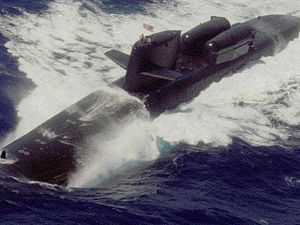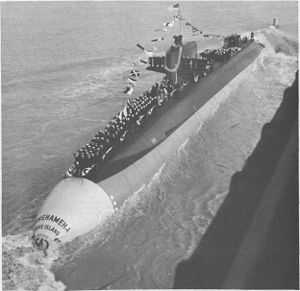USS Kamehameha (SSBN-642)
 USS Kamehameha (SSN-642) after her 1992 conversion to support Navy SEALS as an attack submarine | |
| Career (US) | |
|---|---|
| Namesake: | Kamehameha I (c. 1758-1819), King of Hawaii (c. 1795-1819) |
| Ordered: | 31 August 1962 |
| Builder: | Mare Island Naval Shipyard, Vallejo, California |
| Laid down: | 2 May 1963 |
| Launched: | 16 January 1965 |
| Sponsored by: | Mrs. Samuel Wilder King |
| Commissioned: | 10 December 1965 |
| Decommissioned: | 2 April 2002 |
| Reclassified: | Attack submarine (SSN-642) in 1992 |
| Struck: | 2 April 2002 |
| Motto: |
Imua (Hawaiian for Go forth and conquer) Crew 's unofficial motto: "Kam Do" |
| Nickname: | "Kamfish" |
| Fate: | Scrapping via Ship and Submarine Recycling Program begun October 2002; completed 28 February 2003 |
| General characteristics | |
| Class and type: | Benjamin Franklin-class submarine |
| Displacement: | 6,511 tons light, 7,334 tons full, 823 tons dead |
| Length: | 425 ft (130 m) |
| Beam: | 33 ft (10 m) |
| Draft: | 31 ft (9.4 m) |
| Installed power: | 15,000 shp (11,185 kW) |
| Propulsion: | One S5W pressurized-water nuclear reactor, two geared steam turbines, one shaft |
| Speed: | Over 20 knots (37 km/h; 23 mph) |
| Test depth: | 1,300 feet (400 m) |
| Complement: | Two crews (Blue Crew and Gold Crew) of 20 officers and 130 enlisted men each |
| Armament: | 16 × ballistic missile tubes (removed 1992) 4 × 21 in (533 mm) torpedo tubes (all forward) |
USS Kamehameha (SSBN-642) (called Kamfish by her crew), a Benjamin Franklin-class ballistic missile submarine, was the only ship of the United States Navy to be named for Kamehameha I, the first King of Hawaii (c. 1758-1819). She is one of only two ships of the United States to be named after a monarch.a She was later reclassified as an attack submarine and redesignated SSN-642.
The ship's motto was Imua, which roughly translates (from the Hawaiian) as "go forth and conquer." Another motto used by her crew was Kam do.
Construction and commissioning

The contract to build Kamehameha was awarded to Mare Island Naval Shipyard at Vallejo, California, on 31 August 1962 and her keel was laid down there on 2 May 1963. She was launched on 16 January 1965, sponsored by Mrs. Samuel Wilder King, and commissioned on 10 December 1965 with Commander Roth S. Leddick in command of the Blue Crew and Commander Robert W. Dickieson in command of the Gold Crew.
Conducting deterrence patrols during the Cold War, Kamehameha's armament as a ballistic missile submarine was 16 Poseidon ballistic missiles plus ten to twelve Mark 48 heavy torpedoes non-ADCAP (advanced capability).
Service history
Kamehameha was built by the Mare Island Naval Shipyard in Vallejo, CA. Upon completion she went on her first Sea Trials, off the coast of California. Missile firing tests at Cape Canaveral, Florida, followed, after which, she sailed to Pearl Harbor, Hawaii, which was her home port until 1970. Although Pearl Harbor was her home port, she made all of her Pacific patrols out of Apra Harbor, Guam, in order to permit maximum time on patrol station with minimum transit time to and from port. Maximum time on patrol is also the reason why every ballistic missile submarine has two crews, dubbed Blue and Gold. Early in 1966, Kamehameha joined the United States Pacific Fleet and the Blue Crew began her first deterrent patrol on 6 August 1966. After this patrol in November 1966, the Gold Crew relieved the Blue Crew, and Kam was soon underway again. It was on her last Pacific patrol that the Blue Crew took her to the Pacific Missile Test Range to fire two dummy warhead missiles. The Blue Crew then took Kam into port at Pearl Harbor in preparation for transfer to the Atlantic Fleet.
The Gold Crew relieved the Blue Crew, and spent the next few weeks in Honolulu giving the people of Hawaii the opportunity to go aboard and see the submarine named in honor of the King of Hawaii. In early June, 1970, with the Gold Crew operating the boat, Kam got underway for Charleston, SC, via the Panama Canal, for duty with Submarine Squadron 18, based at Charleston. The submerged transit to the canal took about seven days, and upon arrival off the coast of Panama, Kam surfaced and was met by the Panama Canal pilot who would take her through. The passage through the Panama Canal was given priority by the Canal authorities, and little time was spent waiting to enter. The boat was the object of considerable curiosity from those on ships nearby, and from the onlookers ashore. Once clear of the canal, Kam again submerged and began the final leg of the transit, passing through the Caribbean and out into the Atlantic. [1]
Kam surfaced just east of the Charleston harbor sea buoy, and waited for the tug that was to bring Miss Charleston on board. The information about Miss Charleston was contained in Commander Submarine Squadron 18's message of instructions for Kam's arrival, and had caused a bit of excitement among the bachelor junior officers. As it happened, both the Officer of the Deck, a lieutenant, and the Junior Officer of the Deck, were bachelors, so they both were expectantly scanning the channel. Suddenly, one of the lookouts reported a Navy tug just appearing in the distance. All binoculars were trained on the tug, and the OOD reported, "I see a female standing on the bow!" Thirty seconds later, with some measure of disgust in his voice, he then reported, "Captain, that's not Miss Charleston, that's your wife!" This news left the Captain the only happy man on the bridge. The remark was relayed to a reporter who also had arrived on the tug, and the next day, in the Charleston newspaper, the Society page bore the headline, "That's Not Miss Charleston, That's the Captain's Wife!" It seems Miss Charleston had gone to the wrong pier in the shipyard and thus literally missed the boat. <[1] 971>
Shortly after Kam's arrival, and still under the Gold Crew, she was ordered to sail on patrol earlier than scheduled in order to fill in for another boat that had suffered a casualty to the main engines. Kam exchanged all 16 missiles in less than 24 hours, and also replaced the ship's battery. She then took Commander Submarine Flotilla Six, a rear admiral, on board and proceeded to sea for four days of sea trials, thus giving ComSubFlotSix the opportunity to see just what this new addition to the Atlantic Fleet was like. In the event, Kam passed with flying colors and embarked on her first Atlantic Fleet deterrent patrol.She made two more patrols, one Blue and one Gold, and in April, 1971, was taken by the Blue Crew into the shipyard for major overhaul, including refitting for the newer Poseidon missile system, and refueling of the reactor. On 31 May 1971, the Gold Crew was disbanded for the duration of the overhaul.<ref name "From Green Hills to Blue Seas">((cite journal/ last=Sagerholm)first-James) title= Vice Admiral, USN (Ret.)/ journal=Personal Memoirs / date= June, 2013 [unpublished] / pages=133-135 / accessdate=March, 2014) / </ref> >
- History needed for 1971-1992.
Between 1975 and 1977 she belonged to Submarine Group 2, Squadron 16; homeported in New London CT, and advance-based in Rota Spain. She conducted nuclear deterrent patrols in the Atlantic and 'vicinity' without incident in 1975 and 1976. During September - November 1976, Kamehameha spent time in Charleston, South Carolina conducting SPECOPS with other units, then onto the AUTEC range for qualifications prior to resuming patrol duties after her return to Rota.
The Kam entered Portsmouth Naval Shipyard (PNSY) in xxxx for a non-refueling overhaul. She finished sea trials in late 1982 and worked its way from Groton, CT to Port Canaveral Florida and then to Charlestown for its compliment of ICBMs. While in Charleston the bridge and main compartment experienced flooding when the ship surfaced without air and while riding low took on several hundred gallons of seawater down the main hatch. The story goes that the hatch was closed with a sailor still on the bridge. No one was hurt except the feelings of the gold crew when they had to stay on longer while repairs were completed. The Kam then transferred to Holy Loc Scotland for patrols out of Dunoon Scotland. There she completed patrols 50-58??
Her radio callsign during this period was NKAM.
For much of her operational career, Kamehameha was based at Rota, Spain.
Conversion to attack submarine
In July 1992, Kamehameha was converted to a Dry Deck Shelter/swimmer delivery platform, reclassified as an attack submarine, and given hull number SSN-642; her ballistic missile capability was removed and thereafter she carried only torpedoes as armament. Henceforth there was only one crew, and her subsequent missions included SEAL special warfare operations.
Decommissioning and disposal
Kamehameha was decommissioned on 2 April 2002 and stricken from the Naval Vessel Register the same day. She was the last of the original "41 for Freedom" fleet ballistic missile submarines in service, and the oldest submarine in the United States Navy at the time of her decommissioning. The wardroom of the oldest submarine in the fleet carried Richard O'Kane's personal cribbage board, and upon the Kamehameha's decommissioning the board was transferred to the next oldest boat, USS Parche (SSN-683).[2] She holds the record for the longest service lifetime of any nuclear submarine—nearly 37 years.
Kamehameha 's scrapping via the Nuclear-Powered Ship and Submarine Recycling Program at Bremerton, Washington began in October 2001 and was completed on 28 February 2003.
Commemoration
Kamehameha 's sail with fairwater planes, the upper half of her rudder, her bust of King Kamehameha I, a koa plate, bow and spear, and the wardroom monkeypod wood table are stored at Pearl Harbor, Hawaii. Her periscopes have been donated to the Deterrent Park on Submarine Base Bangor, Washington, to become part of the USS Woodrow Wilson (SSBN-624) exhibit.
Notes
^a The other was the Continental Navy's USS Alfred.
References
- ↑ 1.0 1.1 Sagerholm, James (June 2013). "Vice Admiral, USN (Ret.)". Personal Memoirs: 130–132.
- ↑ "USS Los Angeles Embarks With a Piece of Submarine History". US Navy. 16 May 2007.
- This article incorporates text from the public domain Dictionary of American Naval Fighting Ships. The entry can be found here.
- This article includes information collected from the Naval Vessel Register, which, as a U.S. government publication, is in the public domain. The entry can be found here.
- Photo gallery of USS Kamehameha (SSBN-642) Keel Laying - Launching at NavSource Naval History
- Photo gallery of USS Kamehameha (SSBN-642) Fitting Out - Commissioning at NavSource Naval History
- Photo gallery of USS Kamehameha (SSBN-642) Active Service - Decommissioning at NavSource Naval History
| ||||||||||